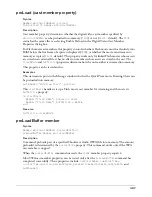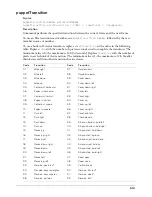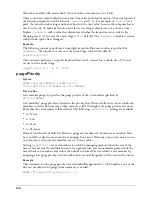
506
Example
t = transform()
t.transform.identity()
t.transform.rotate(0, 90, 0)
t.transform.preTranslate(100, 0, 0)
gbModel = member("scene").model("mars")
gbModel.transform = t
put gbModel.transform.position
-- vector(0.0000, 0.0000, -100.0000)
primitives
Syntax
getRendererServices().primitives
Description
3D function; returns a list of the primitive types that can be used to create new model resources.
Example
This statement display the available primitive types:
put getRendererServices().primitives
-- [#sphere, #box, #cylinder, #plane, #particle]
See also
getRendererServices()
,
newModelResource
print()
Syntax
sprite(
whichSprite
).print({"
targetName
",
#printingBounds
})
Description
Command; calls the corresponding
ActionScript command, which was introduced in Flash
5. All frames in the Flash movie that have been labeled
#p
are printed. If no individual frames
have been labeled, the whole movie prints.
Both arguments to this function are optional. The target movie is the movie or movie clip to be
printed. If you do not specify a target (or if the target is 0), then the main Flash movie is printed.
The two options for the printing bounds are
#bframe
and
#bmax
. If
#bmax
is specified, then the
printing bounds become a large enough virtual rectangle to fit all frames to be printed. If
#bframe
is specified, then the printing bounds for each page are changed to match each frame that is being
printed. If no printing bounds are specified, the bounds of the target movie are used.
Because printing of Flash movies is rather complicated, you may benefit from reviewing the
section about printing in the Flash 5 documentation before using this sprite function.
printAsBitmap()
Syntax
sprite(
whichSprite
).printAsBitmap({"
targetName
",
#printingBounds
})
Description
Command; functions much like the
command. However,
printAsBitmap
can be used to
print objects containing alpha channel information.
Содержание DIRECTOR MX-LINGO DICTIONARY
Страница 1: ...Lingo Dictionary Macromedia Director MX...
Страница 756: ...Index 756...
















































